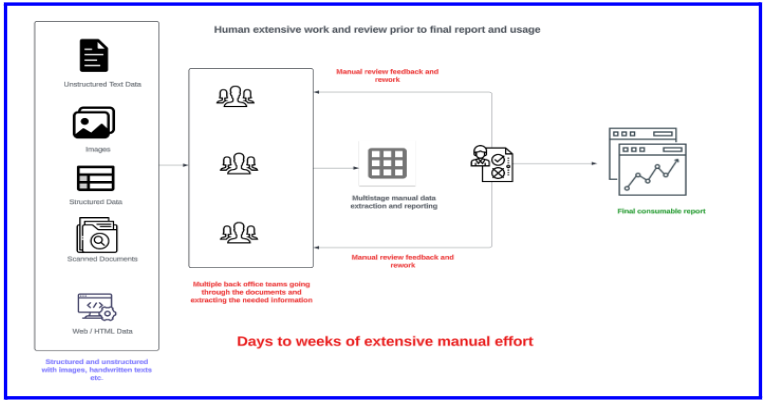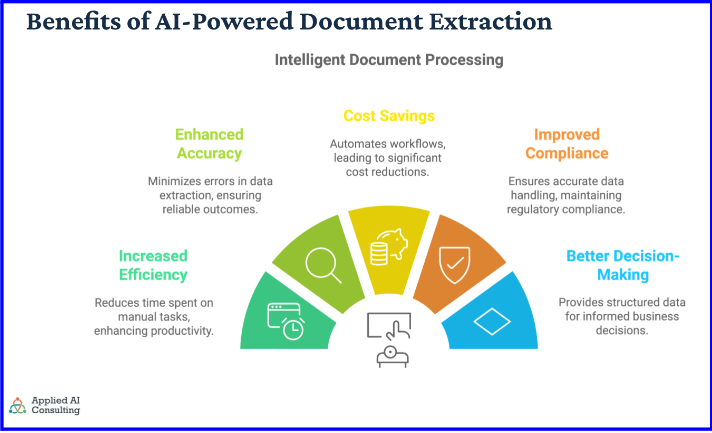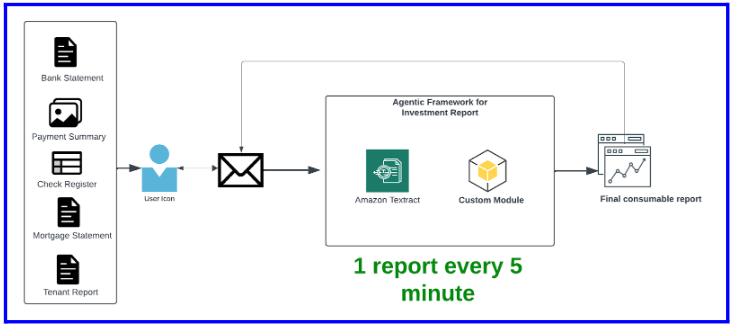With the exponential growth of unstructured data, businesses encounter significant challenges in extracting valuable insights from a variety of documents, including invoices, financial statements, contracts, and more. Document extraction using AI has emerged as a game-changing solution, enabling organizations to automate the process of extracting critical information from these documents with unmatched speed and accuracy. This blog will delve into the mechanics of AI-powered document extraction, examining tools and platforms such as AWS Textract, Azure AI Document Intelligence, Snowflake Document AI, Google Document AI, and custom Python-based solutions. Additionally, we will highlight a success story that demonstrates how technology can be mapped to deliver real value.
What is Document Extraction with AI?
Document extraction with AI refers to the use of artificial intelligence, particularly machine learning (ML), natural language processing (NLP) and optical character recognition (OCR) technologies, to automatically extract text, data, and key insights from unstructured or semi-structured documents. Unlike traditional OCR, which primarily focuses on recognizing text, AI-powered systems can understand document structures, handle complex formats, and extract tables, forms, and metadata with high precision.
Why is Document Extraction Crucial?
I’ve been talking to a CFO in a mortgage processing company and, lately, with an executive at an investment property management firm. In separate conversations, they both talked about the volume of back-office work processing documents using traditional OCR and/or a mix of manual and automated methods.
It’s a fact that businesses across industries like finance, healthcare, legal, and real estate deal with massive volumes of documents. And manually processing these documents is both time-consuming and error-prone.

Hence automating document extraction can significantly improve operational efficiency by:
- Increased Efficiency: Reducing time spent on manual tasks enhancing productivity.
- Enhanced Accuracy: Minimizing errors in data extraction, ensuring reliable outcomes.
- Cost Savings: Automating workflows leading to significant cost reductions.
- Improved Compliance: Ensuring accurate data handling, and maintaining regulatory compliance.
- Better Decision Making: Priding structured data for informed business decisions.

Document Extraction Use Cases
Now that we have a consensus that AI-powered document extraction can bring in significant speed and accuracy, the next steps for every organization are the following
- Identify the use cases where this can help
- Prioritize the use cases based on ROI or customers etc.
- Zero down on tools or a combination of tools that can help solve the use case in the best possible way.
Let’s look at some of the use cases and related values across domains and industries that we have come across during our interaction with customers, prospects, and partners. This can help invigorate some thoughts when we are thinking about use cases and value for our areas of work or our customers.
- Government: Automated form processing, document classification, fraud detection
- BFSI / Mortgage: Extracting data from bank statements, invoices, and contracts for automated financial reporting, KYC compliance, loan processing, and claim processing.
- Healthcare: Processing medical records, insurance claims, clinical trial documentation
- Legal: Analyzing contracts and legal documents to automate compliance and contract lifecycle management.
- Real Estate: Generating property reports by extracting information from lease agreements, mortgage documents, financial records, Investment analysis, etc.

AI Tools for Document Extraction
By now, the use case is identified and prioritized. The next step is finding tools or a combination of tools that can help solve the use case.
And I know, despite it sounding cliche, in reality, every customer problem, though may sound similar, has its challenges and needs a specific solution. That’s where just knowing a tool doesn’t help. And that’s where companies like Applied AI Consulting or other AI native companies come and guide/help consult/implement.
At this point, let’s dive into some of the leading AI-powered document extraction tools and platforms.
AWS Textract is a machine-learning service that extracts text, forms, and tables from scanned documents. It goes beyond simple OCR by recognizing complex document structures, such as key-value pairs and tables, making it ideal for extracting detailed data from financial statements, contracts, and more.
Textract can be integrated with other AWS services like Amazon Comprehend for natural language processing and Amazon SageMaker for custom model training. For businesses handling fintech or mortgage services, AWS Textract is a powerful tool that automates document workflows efficiently.
Microsoft’s Azure AI Document Intelligence (formerly known as Form Recognizer) is another leading AI service that uses machine learning to extract text, tables, and key-value pairs from documents. Azure allows users to create custom models tailored to their document types, which is particularly useful for industry-specific formats.
Azure AI Document Intelligence integrates seamlessly with Azure Cognitive Search to further enhance document processing capabilities, making it an excellent solution for applications requiring both document extraction and search capabilities.
Google Document AI is a powerful platform that utilizes advanced machine learning to extract information from various document types, such as invoices and receipts. It offers pre-trained models for quick deployment and allows for custom model development for specific needs. Seamlessly integrated with Google Cloud services, it automates document processing, making it ideal for industries like finance and healthcare. Key features include intelligent character recognition, form parsing, and table extraction, enabling organizations to enhance efficiency and unlock insights from unstructured data.
For organizations requiring full flexibility, custom Python-based solutions offer a powerful alternative. Python libraries such as Tesseract OCR for text recognition, along with frameworks like SpaCy for natural language processing, allow developers to build tailored document extraction solutions.
Custom Python scripts can be combined with regular expressions (regex) to handle specific document structures
Now that we have more learned about different AI-powered document extraction tools, let us look at a quick comparison to help select the right tool as per your use case and engineering needs.
If you notice, we have added a custom Python-based solution too since no tool is complete and you would need some amount of coding to get the best for your use case also sometimes when the need is for an on-prem solution, that’s where it helps.
All tools and platforms are good and evolving day by day. We, at Applied AI Consulting, work with one or more of these for our different customers or POCs and hence more current with changes and values based on the use cases.
In this blog, we are comparing these tools across the aspects like
- Model Training & Customization
- Document Support & Processing
- Language Support & OCR Accuracy
- Implementation & Integration
- Cost & Scalability
We subjected the same set of documents across these toolsets to compare them across these different aspects.

Quick Insights: Automating Financial Data Extraction
We have worked with multiple customers helping with automated data extraction using different hyperscaler-based tools and open-source custom Python libraries.
Let us look at the use case of a property management company overseeing multiple strip malls and investment properties.
They faced challenges with their slow, manual financial reporting process. Handling hundreds of tenant payments, vendor expenses, and financial documents resulted in delayed decision-making and increased operational costs. Applied AI Consulting was brought in to automate the extraction, categorization, and reconciliation of data from various documents.
Key Challenges:
- Diverse document formats
- Time-consuming manual processes
- High risk of human error
- Lack of real-time reporting
Solution Implemented:
- Used AWS Textract and custom regex for efficient data extraction
- Integrated DynamoDB for report tracking and S3 for secure document storage
- Deployed ECS containers to enhance report generation speed
Results:
- 95% reduction in financial report generation time
- Over 90% reduction in manual errors
- 50% of team time freed up for strategic tasks
This case study demonstrates how automation can significantly improve financial data processing, leading to faster decision-making and increased operational efficiency.

You can read more about this case study here – https://appliedaiconsulting.com/automating-financial-data-extraction/
Wrapping Up: The Future of Document Automation
AI-powered document extraction is revolutionizing the way businesses handle unstructured data. By leveraging platforms like AWS Textract, Azure AI Document Intelligence, Google Document AI, Snowflake Document AI, and custom Python solutions, companies can automate the extraction process, reduce manual work, and enhance the accuracy of their data.
At Applied AI Consulting, we are at the forefront of AI innovation, helping businesses harness the power of document extraction to streamline operations and improve decision-making. Ready to transform your document processing workflows?
Contact us today to learn more.
Disclaimer: The author has used generative AI assistance to generate images and Applied AI accelerator marxeed to structure the blog.